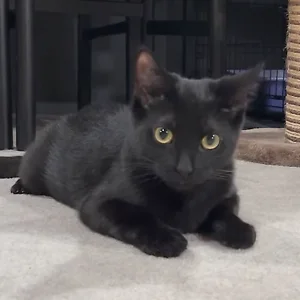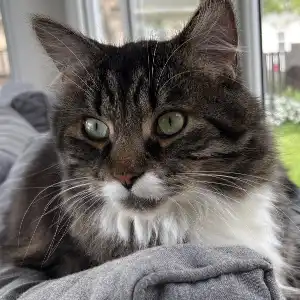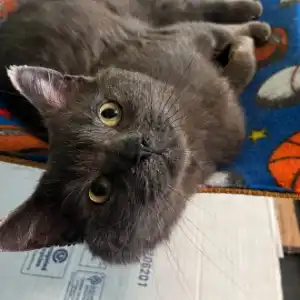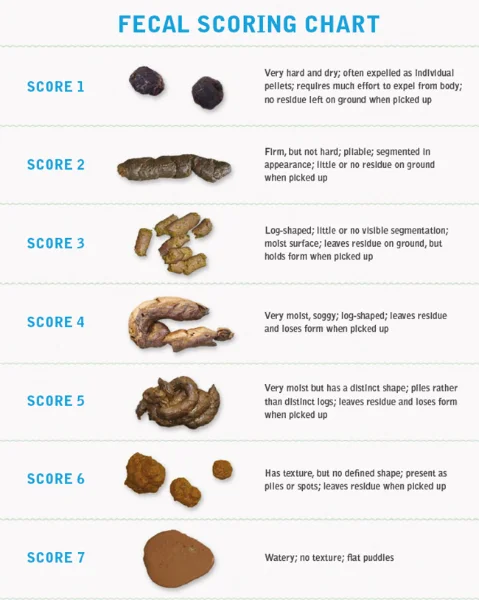Solving Poop Consistency Problems
If there’s one thing I’ve learned over 25+ years of doing cat rescue – cats have poop problems. If they don’t come with a poop problem at the time of rescue, they’ll have one at some point in their lifetime. Intestinal issues are very common in cats. However, what isn’t always straight-forward are the reasons behind the conditions. Parasites, food, medication and medical conditions can all cause intestinal upset. So, if your cat has a poop problem, how do you go about solving it?




Caring people had been feeding Shadow (last photo) in their community for the past few years. He never, willingly, made contact with his caregivers. This summer, he showed up looking sick, weathered and weak and were able to trap him and bring him indoors. He knew he needed help. Because of skyrocketing care costs, WLCA agreed to take him on as he was in one of the managed areas WLCA monitors. He had an upper respiratory infection, was emaciated, had a raging urinary tract infection and chronic, uncontrollable diarrhea.
Shadow was so dehydrated, that he was barely able to function anymore. His bloodwork was out of whack because of the dehydration and he had to be on sub-q fluids daily for a few days, and then every other day once his infections cleared and he was feeling better. His diarrhea became more manageable with his medication on-board. He has since regained his weight and has had an extensive dental.
Although he has recovered from his ordeal, we are still trying different strategies to get a solid poop out of him. We have run the gamut of usual interventions with no luck, but we’re not giving up. Shadow is FIV positive and our vet found severe dysbiosis when his poop was put under a microscope. More about that later in this article. Now that he’s recovered from his dental, he’ll be undergoing more non-invasive tests to see if we can get any new information on his poop situation.
Does Your cat have a poop problem?
Not seeing Tootsie-Roll-like poop in the litterbox? Is anything other than formed poop a problem? Maybe. Maybe not. Although the well-formed, brown log appearance is what we all hope to find in the box, just because your cat has produced something other than a “textbook” poop, doesn’t mean there’s a serious situation at-hand. What is does mean, is you’ll have to keep an eye on it to start off. Your cat’s softer, or harder, poop might be temporary. Maybe you changed their food recently or perhaps they ate some grass or fresh catnip and got some tummy upset. If the consistency and/or color change lasts more than a day or two, or if it’s accompanied by other worrisome symptoms, it’s time to contact your vet. If you rescued a cat and they have had nothing but diarrhea or rock-hard nuggets, they’re going to need a vet visit, too.
The Poop Chart
Did you know there’s a reference chart showing different kinds of cat poop? The fecal scoring chart is an identification system clinics, and shelters, often use to score a cat’s output. The guide clearly communicates to others what kind of poop the cat has on any given day. This is very useful in the treatment of cats with diarrhea or other less-than-acceptable poop. You want your cat’s poop to score a 2, or 3, the majority of the time. If it’s too hard or too soft, that means there’s too little, or too much, fluid in the output. Do your see your cat’s poop on this chart?

poop Color
Did you know you can also be alerted to potential problems by the color of your cat’s poop?
Brown (light to dark) is the normal color of cat poop.
Black poop usually indicates an upper GI bleed.
Grey or pale greasy poop can indicate problems with a cat’s pancreas or bile duct.
Orange or yellow poop can point to a liver, or bile, problem.
Green poop may be food-related (think eating grass or fresh catnip) or possibly a gallbladder issue.
Red blood in poop can alert you to inflammation, infection or trauma.
Mucous on poop is often a sign of inflammation in the large intestine.
What Can affect cat poop?
Parasites and Protozoans
One of the first things I do when I rescue a cat is deworm them. Homeless cats often eat live prey, or live out of dumpsters and food left outside for them. While many of them manage to find feeding stations that have clean food and water, that’s not the reality for a lot of cats. Live prey can transmit intestinal parasites (roundworm, hookworm), as can fleas (tapeworm). Drinking contaminated water and eating contaminated food can result in intestinal protozoans like campylobacter, cryptosporidium, giardia and coccidia. These, along with other nasties, can cause diarrhea and other health issues, if not addressed. Your vet will be able to prescribe medication if your cat has acquired a protozoan or intestinal worms.
Diet
Some cats seem to be able to eat anything without stomach upset, while others can get diarrhea with the slightest diet change. Cats who have been out on their own for some time often have more than one thing going on. Homeless cats often don’t have a consistent food source and as a result, their intestines experience frequent changes that are hard to deal with. Some cats have a tough time finding water, especially in the winter when most people have dry cat food out and water freezes quickly. Heated water dishes become very important because cats don’t normally eat snow. They can get dehydrated, and subsequently constipated. Likewise cats who have chronic diarrhea, without a consistent water source, will also get dehydrated. Neither scenario is good for them and should be addressed.
allergies and intolerances
Allergies and intolerances are also high on the list for GI upset. Many cats get itchy if they are allergic to their food, but others vomit or get diarrhea. It’s worth doing a diet trial if deworming hasn’t worked, protozoans have been killed (or not found at all) and the problem persists. Some cats with diarrhea, or constipation, do better on a high fiber diet, while others do better on a low residue diet.
In either case, cats need adequate fluid intake. If your cat only eats dry cat food, constipation might result if they don’t get enough water to compensate for what the dry requires to pass easily. Cats with diarrhea on a dry food diet without enough water to compensate for what the food will absorb AND the fluid losses from the diarrhea, will wind up like Shadow. More often than not, you’ll need to put your detective hat on and really pay attention to what your cat is doing.
Stress
Believe it or not, cats get stress diarrhea. Many shelter cats have diarrhea and if the usual interventions don’t seem to help, a stay with a foster family often does the trick. Being in an unfamiliar place, with unfamiliar people stresses cats out. They love consistency. Anything out of the ordinary can upset their GI tract – from vomiting to diarrhea or constipation. Shelter cats stress each other out, compounding their anxiety. Hugo, one of our handsome rescue cats, had diarrhea when we trapped him.
We were able to resolve the problem with a consistent canned diet and a stable environment with predictable feeding times. A lovely family adopted him but their active, young dog chased him around. That resulted in stress diarrhea. His family surrendered him back to WLCA and we sent him to a new foster home where his problem disappeared and he thrived in their quiet environment. Hugo is now doing wonderfully in his new adoptive home, with his calm and respectful doggie friend, consistent food and feedings and a lot of attention from his people.
dysbiosis
Dysbiosis is a gut that doesn’t have a healthy amount of good bacteria. All cats have good, and bad, bacteria in their intestines (as do we) but if the bad bacteria takes over, you can bet your cat will suffer from gas, bloating and diarrhea. Adding prebiotics and probiotics to their diet will help their gut rebalance. If your cat is on antibiotics, which can also cause dysbiosis, they should also be on probiotics to counteract the effects of wiping out good, in addition to bad, bacteria.
Medical conditions
liver dysfunction
While some conditions are pretty straight-forward to diagnose, others are a real challenge. Blue’s liver was ailing since we picked him up as a 12 week old kitten. He had chronic diarrhea and severe thirst. He was literally emptying his water bowl several times a day. When we had his bloodwork done, we discovered one of his liver function values was very high. Diagnostic imaging revealed nothing abnormal. It was a mystery, but what we did know is when your liver isn’t functioning right, you have a good chance of having diarrhea as well.
We got him on liver support supplements and over time, his liver value came down considerably. We don’t know if it would have come down anyway as he got older, but the addition of the supplement didn’t hurt. At his dental, his liver value was still above normal, but going in the right direction. Our hope is once his liver function value is within normal limits, his diarrhea will improve.
FIV/Feline Leukemia
FIV and Feline Leukemia are conditions that render the victim immunocompromised. That means they have a hard time fighting infections and can have chronic inflammation. Shadow is FIV positive. He still has diarrhea even with the addition of probiotics and digestive enzymes. If he is fighting to rebalance his gut, FIV isn’t on his side. He has been on a high fiber diet, antibiotics with anti-inflammatory properties, a novel protein diet, and a hydrolyzed diet. More tests are coming up for him, but he’s the happiest he’s been in a long time and his foster home is super patient and accommodating. He’s a lucky boy.
Hyperthyroidism
I remember a kitten we rescued wound up with hyperthyroidism in his later years. One of the first symptoms we noticed, before we knew he had it, was chronic diarrhea. The other, more common symptoms, came later and that’s when we put it all together. Once Opie was on methimazole, his poop went back to normal, he put weight back on, he stopped roaming the house aimlessly and was his happy self again.
Exocrine Pancreatic insufficiency
This condition isn’t very common, but if all else has failed, there is a test for it. The reason these cats have chronic diarrhea is because their pancreas doesn’t produce the enzymes needed to digest their food. These cats also have trouble keeping weight on even though they’re ravenously hungry. They also have other symptoms including B12 deficiency, a poor coat and vomiting. Thankfully, prescription pancreatic enzymes help them digest their food and regain their health.
megacolon
On the other end of the poop spectrum we have constipation. Although many cats are chronically dehydrated, once fluids are restored, their poop is easier to pass. Megacolon is a condition whereby the colon is permanently overstretched and weakened due to chronic constipation or secondary to other factors. It stops functioning properly and has a hard time moving poop along and out. This is a very serious condition, so chronic constipation, or the underlying cause, needs to be addressed before megacolon sets in.
talking to your vet
There are a lot of other conditions that could result in diarrhea, or constipation, so your best bet is to contact your vet and discuss what has been going on with your cat. As you can see, some conditions are transient, and simple, while others require more investigation and testing.
Our rescue cats with chronic diarrhea, collectively, have been through deworming, antibiotics, anti-inflammatories, anti-anxiety medication, fecal smears, diet trials, nutritional supplementation, pathogen testing, GI panels and ultrasounds. It’s sounds like a lot, but most cats won’t have to go through all of it to figure out what’s going on.
Each intervention takes some time to become effective, if it’s going to work, so there is usually two to four weeks between each change. For instance, if your vet suspects your cat has a food intolerance, a new food would have to be fed long enough for your cat’s system to adjust and reflect the change. Likewise with some medications. I highly recommend the one-thing-at-a-time approach, so you know what worked and what didn’t.
before your appointment
- Take photos of your cat’s abnormal poop and call your vet. You can’t save poop for testing, but you could bring it in for them to see what you’re talking about, if they prefer. In order to examine it under a microscope, they’ll likely want to take a fresh swab directly from your cat. This is also true if they need to send it away for testing.
If you rescued a cat with this problem, you may not have a normal baseline to go by unless you’ve picked up their poop in the past. Any new rescue cat MUST go to the vet within a few days of bringing them in. Why? Parasites, protozoans and other conditions may not be obvious to you, but could be very obvious to a vet. They can provide immediate relief and your quest for solid poop might end there. You also don’t want to transmit these organisms to any other pets in the home. Keep them separated and wash your hands after handling them and scooping the litterbox. - Write down what your cat is eating (canned, dry and treats) and how much they drink throughout the day, the date your cat’s poop changed and if they ate anything different that day. Also note if anything stressful happened to your cat recently. The more info your vet has, the better they’ll be able to help.
If a cat YOU just rescued came with a poop problem, write down what you have been feeding them outside (if you have a feeding station) and anything else you may have left for them (treats, cooked meat). Bring your info with you to your vet appointment. - Take note of how many times your cat has been going to the litterbox to poop in a 24 hour period for diarrhea and how often your cat poops if they have constipation. Make a point of checking to see if your cat is straining to poop, whether they have diarrhea or constipation.
- If you wind up at a vet who doesn’t see your cat regularly, be sure to write down any medications, or supplements, your cat is on for your visit.
- Be sure to tell your vet about any unusual behaviour or other symptoms your cat is displaying. Hiding, pooping outside the box, not eating, yowling while pooping and being aggressive with other housemates can be a cat’s way of telling you something isn’t right. These behaviours can also add pieces to the puzzle your vet is trying to solve.
One last note
If you cannot afford a test/treatment your vet recommends, tell them what you CAN afford and ask them to work within your budget to solve the problem. Most vets are sympathetic when it comes to financial limitations and will be able to offer you treatment options. For cats who seem to have chronic loose poop, empathy, helping them clean their behind and diligent litterbox cleaning are essential until the right combination of interventions are found. For those with constipation, plenty of fluids, in addition to any vet care recommended, will ensure a more comfortable experience in the box. With patience, most poop problems can be resolved.
